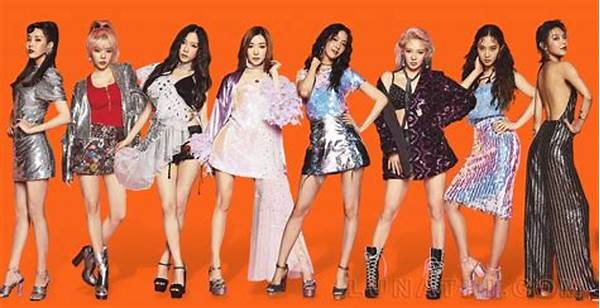If there’s one thing that K-pop always knows how to do, it’s serve up some serious style inspiration. From flashy stage costumes to everyday airport fashion, K-pop stars never shy away from making bold statements. One particularly fascinating trend that has been capturing the hearts of fans worldwide is the androgynous style in K-pop. This trend is all about mixing gender norms and creating looks that anyone can rock. So, let’s dive into the world of K-pop fashion and explore this exciting style phenomenon!
Read Now : Fashion-forward Color Mixing In K-pop
The Rise of Androgynous Style in K-Pop
K-pop has never been just about the music; it’s a full-scale spectacle that charms its audience with synchronized dance moves and head-turning fashion. Over recent years, the androgynous style in K-pop has gained significant traction, resonating with fans who are drawn to its unique and boundary-breaking vibe. Artists are increasingly embracing wardrobes that blur traditional gender lines, creating looks that are both versatile and edgy.
The androgynous style in K-pop allows idols to express their creativity freely, often resulting in fashion choices that surprise and delight. Think oversized suits, statement accessories, and playful layering that defy stereotypes. This trend not only challenges conventional fashion rules but also celebrates individuality, offering fans a refreshing perspective on gender and clothing. As the K-pop industry continues to grow globally, this trend has shown no signs of slowing down, bringing a nuanced and inclusive style to center stage.
Elements of Androgynous Style in K-Pop
1. Layering: Androgynous style in K-pop often features creative layering, allowing idols to mix and match pieces for unique looks.
2. Oversized Clothing: Loose-fitting, oversized garments are a key component in achieving an androgynous vibe in K-pop.
3. Neutral Tones: Many K-pop stars opt for neutral colors to maintain an inclusive and versatile style.
4. Bold Accessories: Statement accessories are a staple in androgynous style in K-pop, adding flair to any outfit.
5. Mixing Textures: Combining different fabrics and textures helps in crafting visually interesting and androgynous looks.
Gender Expression Through Androgynous Style
K-pop idols aren’t only pushing musical boundaries; they’re also redefining fashion norms. By embracing the androgynous style in K-pop, these artists explore new ways of expressing their gender identity. Androgynous fashion breaks away from the traditional divide of “men’s” and “women’s” clothing, encouraging a more fluid approach to self-expression. It’s about mood, confidence, and attitude more than labels.
The courage of these idols to step outside conventional boundaries has inspired many fans around the world. K-pop’s ability to influence extends beyond music charts and into real-world attitudes, helping to normalize a broader spectrum of gender expression. With fans and idols alike embracing this style, it’s clear that androgynous fashion in K-pop isn’t just a trend—it’s part of a larger movement towards greater inclusivity in the industry.
Read Now : Cutting-edge Visual Effects Technology
Celebrities Embracing Androgynous Style
The Impact of Androgynous Style on Fans
With its inclusive nature, the androgynous style in K-pop deeply resonates with fans of all genders. It’s more than just clothing—it’s a movement. Fans find empowerment in their favorite idols’ ability to express themselves without societal constraints. The message is clear: fashion is personal, and traditional rules are meant to be broken. The acceptance and admiration shown by fans for this trend underscore its influential power.
As androgynous fashion becomes more mainstream in K-pop, it also encourages discussions around gender and self-expression. Fans are increasingly encouraged not only to emulate their idols’ styles but also to explore their own identity through fashion. The influences of these idols go far beyond their music, prompting fans to think critically about what fashion means in the context of identity and freedom.
Future of Androgynous Style in K-Pop
Androgynous style in K-pop is more than just a fleeting trend; it’s a glimpse into the future of fashion in the industry. As K-pop continues to dominate the global stage, its stylistic choices will undoubtedly influence broader fashion trends around the world. It’s likely we’ll see even more innovative style combinations that challenge existing perceptions of gender and fashion.
In an industry that thrives on evolution and creativity, androgynous fashion offers limitless potential. It reflects a progressive movement that embraces diverse expressions of gender and identity. By celebrating their individuality, K-pop idols set a powerful example for fans to do the same, fostering a more inclusive and accepting world. So, the next time you spot a K-pop idol sporting an androgynous look, remember—it’s not just fashion; it’s a statement.
Summary: The Power of Androgyny
The androgynous style in K-pop isn’t just a trend; it’s an embodiment of a cultural shift towards inclusivity. Emphasizing individual expression and breaking down traditional gender roles, it fits right into the diverse tapestry of K-pop. It’s a testament to the genre’s willingness to challenge norms and constantly redefine its boundaries.
Fans appreciate how this trend offers a refreshing take on fashion, making it accessible and relatable. Whether through oversized suits, bold accessories, or gender-neutral hues, androgynous style in K-pop has become a mode of self-expression that goes beyond mere aesthetics. It’s part of an ongoing dialogue about identity, confidence, and freedom. So, as you keep up with your favorite K-pop stars, watch how this inclusive fashion trend continues to evolve and influence—both on and off the stage.


